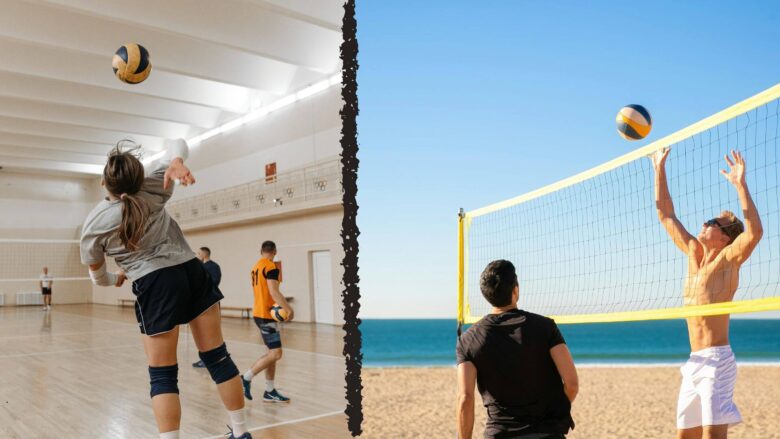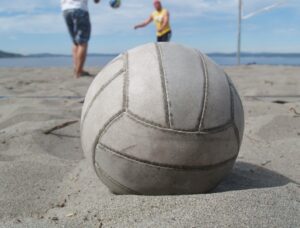Why the Right Gear Matters
While beach and indoor volleyball share the same core rules and objectives, the environments couldn’t be more different. Sand and hardwood, sunlight and artificial lighting, wind and climate control—these factors dramatically influence how the game is played and what gear you need to perform at your best.
Many players mistakenly assume they can use the same gear for both formats. In reality, playing beach volleyball with indoor shoes or using a court ball on the sand can hurt your performance and potentially lead to injury. This guide will walk you through the key differences in gear between beach and indoor volleyball and help you choose the right equipment for your game.
Court Conditions and Physical Demands
Before diving into the gear specifics, it’s important to understand how the environment shapes the nature of the game. The court surface, team structure, and playing atmosphere all influence the style, intensity, and demands placed on the player.
Indoor Volleyball
- Played on a flat, polished hardwood court designed for high-traction movement
- Fast-paced game with high jumps, quick lateral transitions, and intense spikes
- Teams typically consist of 6 players, allowing for specialized roles (setter, libero, blocker, etc.)
- Indoor gyms are climate-controlled, eliminating external variables like wind or sun
- Consistent lighting and even flooring provide a predictable playing surface
This environment encourages explosive athleticism, fine-tuned coordination, and rapid transitions. The uniformity of the court allows for power-focused strategies and quick, sharp reflexes.
Beach Volleyball
- Played on deep, loose sand that absorbs impact and reduces bounce
- Slower-paced movement due to resistance from the sand, requiring more effort for every step
- Teams consist of only 2 players, demanding versatility and full-court coverage
- Outdoor conditions vary dramatically: sun, wind, rain, humidity, and temperature shifts all affect gameplay
- Uneven terrain and glare can challenge visibility and movement
On the sand, players must rely more on stamina, core strength, and balance. The game becomes less about vertical speed and more about endurance, finesse, and smart positioning. The smaller team size also means players must master all aspects of the game—serving, receiving, setting, and attacking.
Bottom line: While indoor volleyball emphasizes power, speed, and specialization, beach volleyball demands adaptability, endurance, and all-around skill. These core differences set the stage for the distinct gear choices required in each format.
Before diving into the gear specifics, it’s important to understand how each setting changes the way the game is played:
Indoor Volleyball
- Played on a flat, smooth hardwood court
- Faster-paced, high-jump, high-speed rallies
- Typically 6 players per side
- Climate-controlled, no weather variables
Beach Volleyball
- Played on deep sand
- Slower movements, harder to jump
- Usually 2 players per side
- Outdoor conditions—sun, wind, heat, cold all play a role
Because of these differences, the physical demands placed on the player’s body vary significantly. Indoor volleyball emphasizes speed, power, and vertical explosiveness, while beach volleyball demands endurance, balance, and agility in shifting sand.
Shoes: Sand vs. Hardwood
Footwear is one of the most critical distinctions between indoor and beach volleyball. The surface you play on drastically changes how your body moves—and your shoes need to accommodate that. Using the wrong footwear can impair performance, reduce comfort, and even increase the risk of injury.
Indoor Volleyball Shoes
- Gum rubber soles for exceptional grip on smooth gym floors
- Cushioned midsoles (EVA, Gel, or Foam) designed to absorb impact from repeated jumps
- Lateral support structures to prevent ankle rolls during quick pivots and dives
- Enclosed, breathable design with mesh or moisture-wicking lining
Indoor shoes are built for speed, stability, and support. They’re lightweight, yet reinforced to handle explosive movements, especially jumping and lateral cutting. Traction is essential in indoor volleyball, where split-second reactions make the difference between a successful dig and a point lost.
Popular models: ASICS Sky Elite FF, Mizuno Wave Momentum, Nike React Hyperset
Beach Volleyball Footwear
- Most commonly played barefoot, allowing toes to grip the sand for better balance and traction
- Some players use sand socks, which protect against hot sand, rocks, or cold temperatures without sacrificing feel
- Specialized minimalist beach shoes are used in rare cases, often during colder weather or on rough surfaces; these are thin, flexible, and quick-drying
Beach volleyball demands strong foot muscles and natural mobility. The softness of the sand provides shock absorption but also makes movement more difficult. Going barefoot enhances connection to the terrain, offering better control in unstable conditions.
Why it matters: Indoor shoes are not designed for sand—they trap grains, lose structure quickly, and offer no traction in loose surfaces. Likewise, playing barefoot or with beach gear on hardwood can result in slips, burns, or a lack of foot support.
Bottom line: Your footwear must match your environment. Indoor players need responsive, cushioned shoes with excellent grip, while beach athletes rely on their feet’s natural mechanics or minimalist protection to move fluidly on unpredictable surfaces.
Indoor Volleyball Shoes
- Gum rubber soles for grip on smooth floors
- Cushioned midsoles for repeated jumping
- Lateral support to handle fast, sharp movements
- Breathable but enclosed design
Popular models: ASICS Sky Elite FF, Mizuno Wave Momentum, Nike React Hyperset
Beach Volleyball Footwear
- Often played barefoot for better traction and balance
- Some players wear sand socks to protect from hot surfaces, debris, or cold sand
- Specialized minimalist beach shoes are rare but exist for specific conditions
Why it matters: Indoor shoes can’t be used on sand—they trap debris, offer no flexibility, and wear out quickly. Beach play barefoot requires stronger foot muscles but allows greater mobility.
Apparel Differences
Your clothing choice in volleyball isn’t just about style—it plays a significant role in performance, comfort, and even safety. Beach and indoor volleyball environments demand apparel that suits their unique physical and environmental challenges.
Indoor Gear
- Form-fitting jerseys and tops are common to minimize loose fabric that could interfere with movement or play.
- Athletic shorts or spandex allow for full range of motion while offering breathability and comfort.
- Knee pads are essential due to the frequency of dives and slides on hard court surfaces.
- Ankle braces or compression sleeves are frequently worn to prevent injury from repeated jumping and lateral motion.
Materials used for indoor gear prioritize moisture-wicking and stretchability. Indoor players typically wear layers that keep muscles warm and flexible during breaks or rotations.
Beach Gear
- Men usually wear sleeveless shirts or tank tops with board shorts that allow airflow and quick drying.
- Women commonly wear sports bikinis, tankinis, or fitted athletic tops with sand-resistant shorts for better movement and heat regulation.
- Protective accessories like sunglasses, visors, and long-sleeve UV-blocking tops are common to shield players from intense sunlight and glare.
- Sand-resistant seams and quick-drying fabrics are critical to avoid irritation, chafing, and overheating.
Beach gear must handle extreme conditions: hot sun, blowing wind, abrasive sand, and high sweat levels. That means a heavy emphasis on cooling, drying, and protection features.
Pro Tip: Invest in performance fabrics with SPF ratings and antibacterial technology. Not only will you stay cooler and more comfortable, but you’ll also protect your skin and gear from premature wear caused by sun and salt exposure.
Bottom line: While indoor volleyball gear focuses on function and support under controlled conditions, beach apparel is all about endurance, heat management, and freedom of movement under unpredictable outdoor elements.
Indoor Gear
- Lightweight, form-fitting jerseys
- Breathable athletic shorts or spandex
- Knee pads and ankle braces are common
Beach Gear
- Men typically wear tank tops and board shorts
- Women often wear sports bikinis or tank tops with sand-optimized shorts
- Hats, sunglasses, and long sleeves are used for sun protection
Pro Tip: Always look for UV-protective, quick-drying fabrics for beach environments. Sand-resistant stitching and materials prevent chafing and skin irritation.
Volleyballs: Indoor vs. Outdoor
| Feature | Indoor Volleyball | Beach Volleyball |
|---|---|---|
| Surface | Smoother, tighter panels | Softer texture, slightly rough |
| Size | Smaller (65–67 cm) | Slightly larger (66–68 cm) |
| Weight | Heavier | Lighter for float in wind |
| Pressure | Higher psi (4.3–4.6) | Lower psi for softer touch |
| Weatherproofing | Not needed | Water- and sun-resistant coating |
Using the wrong ball type will drastically affect play. Indoor balls on sand tend to bounce unpredictably and wear out faster, while beach balls indoors feel too light and don’t respond well to hard hits.
Best Indoor Models: Mikasa V200W, Molten FLISTATEC
Top Beach Balls: Wilson AVP Official, Mikasa VLS300
Accessories and Safety Gear
Knee Pads
- Crucial for indoor play due to frequent floor contact
- Rarely used on the beach (sand cushions falls)
Ankle Braces
- Common indoors due to high jump frequency and quick landings
- Less common on sand due to natural shock absorption
Sunglasses and Hats
- Nonexistent indoors
- Essential outdoors for visibility and sun protection
Hydration Gear
- Needed in both settings, but beach players require extra hydration planning due to heat and sweat loss
- Consider insulated water bottles and electrolyte supplements
Environmental Considerations
| Factor | Indoor Volleyball | Beach Volleyball |
|---|---|---|
| Temperature | Controlled | Variable (heat, cold) |
| Lighting | Artificial, consistent | Natural, glare may affect visibility |
| Surface | Hard, consistent grip | Soft, unstable footing |
| Footwear | Essential | Optional or minimal |
These differences affect gear longevity too. For example, beach gear often needs rinsing after each session to remove salt and sand, while indoor gear requires airflow and deodorizing after intense gym sessions.
Travel and Portability
Beach volleyball often involves travel to open areas, tournaments, or parks. That means:
- You may need a portable net system
- Sand stakes and boundary lines
- A large gear bag with compartments for sandy gear
Indoor players typically store their gear in a backpack or duffel and rarely need to bring large equipment themselves—courts and nets are already set up.
Mental & Physical Adaptation
Switching between beach and indoor volleyball isn’t just about gear—it also involves mindset and technique.
- Beach play enhances balance and endurance
- Indoor play develops power and precision
- Many pro players cross-train between both to round out their skills
If you’re planning to transition between formats, invest in appropriate gear and allow your body time to adjust. Beach volleyball requires different foot engagement, slower reaction time, and more emphasis on all-around skills due to the smaller team size.
Final Verdict: Do You Need Different Gear?
Yes—absolutely. While your fundamentals may carry over between indoor and beach volleyball, your gear must adapt to the setting. What works perfectly on a hardwood court won’t necessarily hold up in hot, shifting sand.
Choosing the right shoes, ball, and clothing can boost your performance, reduce injury risk, and increase your overall enjoyment of the game.
If you’re a player who loves both formats—or plans to try one after mastering the other—invest in gear that fits the environment. You’ll play better, feel better, and stay safer.
🏐 Curious about the best beach volleyball balls or indoor gear kits? Stay tuned for our upcoming detailed reviews and buying guides!
Explore More:
- Learn about the Top 10 Knee Pads for Volleyball Players: Comfort & Protection



